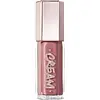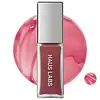Fenty Beauty Gloss Bomb Color Drip Lip Cream Versus Haus Labs By Lady Gaga PhD Hybrid Lip Glaze Plumping Gloss
What's inside
What's inside
 Key Ingredients
Key Ingredients

 Benefits
Benefits

 Concerns
Concerns

 Ingredients Side-by-side
Ingredients Side-by-side

Polybutene
Diisostearyl Malate
EmollientBis-Diglyceryl Polyacyladipate-2
EmollientOctyldodecanol
EmollientCaprylic/Capric Triglyceride
MaskingPolyethylene
AbrasiveSilica
AbrasiveButyrospermum Parkii Butter
Skin ConditioningEthylhexyl Palmitate
EmollientPhenoxyethanol
PreservativeTocopherol
AntioxidantCetearyl Alcohol
EmollientParfum
MaskingTribehenin
EmollientHelianthus Annuus Seed Oil
EmollientCera Microcristallina
Emulsion StabilisingRetinyl Palmitate
Skin ConditioningSorbitan Isostearate
EmulsifyingMica
Cosmetic ColorantLactic Acid
BufferingPalmitoyl Tripeptide-1
Skin ConditioningCitric Acid
BufferingTitanium Dioxide
Cosmetic ColorantCI 19140
Cosmetic ColorantCI 45410
Cosmetic ColorantCI 73360
Cosmetic ColorantCI 15850
Cosmetic ColorantCI 77499
Cosmetic ColorantPolybutene, Diisostearyl Malate, Bis-Diglyceryl Polyacyladipate-2, Octyldodecanol, Caprylic/Capric Triglyceride, Polyethylene, Silica, Butyrospermum Parkii Butter, Ethylhexyl Palmitate, Phenoxyethanol, Tocopherol, Cetearyl Alcohol, Parfum, Tribehenin, Helianthus Annuus Seed Oil, Cera Microcristallina, Retinyl Palmitate, Sorbitan Isostearate, Mica, Lactic Acid, Palmitoyl Tripeptide-1, Citric Acid, Titanium Dioxide, CI 19140, CI 45410, CI 73360, CI 15850, CI 77499
Polybutene
Triisostearoyl Polyglyceryl-3 Dimer Dilinoleate
EmollientDiisostearyl Malate
EmollientOctyldodecanol
EmollientPolyglyceryl-2 Triisostearate
EmulsifyingC18-38 Alkyl Hydroxystearoyl Stearate
EmollientSilica
AbrasiveOpuntia Ficus-Indica Seed Oil
EmollientPalmitoyl Tripeptide-37
Skin ConditioningPalmitoyl Tripeptide-1
Skin ConditioningPalmitoyl Tripeptide-38
Skin ConditioningPortulaca Pilosa Extract
Skin ConditioningSqualane
EmollientEthylhexyl Palmitate
EmollientTribehenin
EmollientTocopherol
AntioxidantSucrose Cocoate
EmulsifyingTriethoxycaprylylsilane
Galactoarabinan
Caprylyl Glycol
EmollientCetearyl Ethylhexanoate
EmollientGlycerin
HumectantMalic Acid
BufferingLactic Acid
BufferingSorbitan Isostearate
EmulsifyingIsostearyl Alcohol
EmollientHexylene Glycol
EmulsifyingEthyl Vanillin
MaskingWater
Skin ConditioningIsostearic Acid
CleansingEthylhexylglycerin
Skin ConditioningSodium Sulfate
Phenoxyethanol
PreservativeCI 77491
Cosmetic ColorantCI 77891
Cosmetic ColorantCI 15850
Cosmetic ColorantCI 19140
Cosmetic ColorantPolybutene, Triisostearoyl Polyglyceryl-3 Dimer Dilinoleate, Diisostearyl Malate, Octyldodecanol, Polyglyceryl-2 Triisostearate, C18-38 Alkyl Hydroxystearoyl Stearate, Silica, Opuntia Ficus-Indica Seed Oil, Palmitoyl Tripeptide-37, Palmitoyl Tripeptide-1, Palmitoyl Tripeptide-38, Portulaca Pilosa Extract, Squalane, Ethylhexyl Palmitate, Tribehenin, Tocopherol, Sucrose Cocoate, Triethoxycaprylylsilane, Galactoarabinan, Caprylyl Glycol, Cetearyl Ethylhexanoate, Glycerin, Malic Acid, Lactic Acid, Sorbitan Isostearate, Isostearyl Alcohol, Hexylene Glycol, Ethyl Vanillin, Water, Isostearic Acid, Ethylhexylglycerin, Sodium Sulfate, Phenoxyethanol, CI 77491, CI 77891, CI 15850, CI 19140
 Reviews
Reviews

Ingredients Explained
These ingredients are found in both products.
Ingredients higher up in an ingredient list are typically present in a larger amount.
Ci 15850 is the pigment color red. It is an azo dye and created synthetically.
Azo dyes need to be thoroughly purified before use. This allows them to be more stable and longer-lasting.
This ingredient is common in foundations, lipsticks, and blushes. This color is described as brown/orangey red.
It has many secondary names such as Red 6 and Red 7. According to a manufacturer, Red 6 usually contains aluminum.
Learn more about CI 15850CI 19140 is also known as Tartrazine. Tartrazine is a synthetic dye used in cosmetics, foods, and medicine to add a yellow color.
Tartrazine is created from petroleum and is water-soluble.
Some people may experience allergies from this dye, especially asthmatics and those with an aspirin intolerance.
Learn more about CI 19140Diisostearyl Malate is an emollient and most often used in lip products. It comes from isostearyl alcohol, a fatty acid, and malic acid, an AHA.
As an emollient, Diisostearyl Malate helps create a thin film on your skin to trap moisture in. This helps keep your skin soft and smooth.
Ethylhexyl Palmitate, also known as octyl palmitate, is created from 2-ethylhexyl alcohol and palmitic acid. It is a fatty acid ester.
The fatty acid content of Ethylhexyl Palmitate makes it an emollient. Emollients help soften and hydrate your skin by trapping moisture within.
Ethylhexyl Palmitate is also used to help improve the texture of cosmetics. It helps other ingredient dissolve in products and help disperse ingredients more evenly.
You'll likely find this ingredient in sunscreen, as it is often used to mix UV-blocking ingredients such as avobenzone and ethylhexyl triazone.
It can also help stabilize the fragrances in a product as a fragrance fixative.
Ethylhexyl Palmitate can be used to substitute mineral oil.
Due to its high fatty acid content, it may not be fungal-acne safe.
Learn more about Ethylhexyl PalmitateLactic Acid is another well-loved alpha hydroxy acid (AHA). It is gentler than glycolic acid but still highly effective.
Its main role is to exfoliate the surface of the skin by loosening the “glue” that holds dead skin cells together. Shedding those old cells leads to smoother, softer, and more even-toned skin.
Because lactic acid molecules are larger than glycolic acid, they don’t penetrate as deeply. This means they’re less likely to sting or irritate, making it a great choice for beginners or those with sensitive skin.
Like glycolic acid, it can:
Lactic acid also acts as a humectant (like hyaluronic acid). It can draw water into the skin to improve hydration and also plays a role in the skin's natural moisturizing factor (NMF) in the form of sodium lactate.
Studies show it can boost ceramide production to strengthen the skin barrier and even help balance the skin’s microbiome.
To get results, choose products with a pH between 3-4.
Lower strengths (5-12%) focus on surface exfoliation; higher strengths (12% and up) can reach deeper in the dermis (deeper, supportive layer) to improve skin texture and firmness over time.
Though it was originally derived from milk, most modern lactic acid used in skincare is vegan. It is made through non-dairy fermentation to create a bio-identical and stable form suitable for all formulations.
When lactic acid shows up near the end of an ingredient list, it usually means the brand added just a tiny amount to adjust the product’s pH.
Legend has it that Cleopatra used to bathe in sour milk to help reduce wrinkles.
Lactic acid is truly a gentle multitasker: it exfoliates, hydrates, strengthens, and brightens. It's a great ingredient for giving your skin a smooth, glowing, and healthy look without the harshness of stronger acids.
Read more about some other popular AHA's here:
Learn more about Lactic AcidOctyldodecanol is a fatty alcohol. It is primarily used to enhance the texture of products.
As an emulsifier, Octyldodecanol helps prevent the oils and waters from separating. It also prevents ingredients from creating foam when shaken.
Octyldodecanol is created by reducing fatty acid to an alcohol.
Due to its high molecular weight, it does not get absorbed into the skin.
Learn more about OctyldodecanolPalmitoyl Tripeptide-1 is also known as pal-GHK. It is made up of 3 amino acids and palmitic acid, a fatty acid that helps it absorb into skin more easily.
This peptide is as a signal peptide, meaning it tells the skin to produce more collagen. Collagen is the key protein that helps form the skin's structure and keep it plump, firm, and hydrated.
By boosting collagen production, this ingredient supports a stronger skin barrier and helps reduce the appearance of wrinkles.
You'll most likely see this ingredient paired with Palmitoyl Tetrapeptide-7 in the well-known Matrixyl 3000 complex. While results from in-house testing should be viewed cautiously, this peptide duo is among the most studied and widely used in modern skincare.
Due to its palmitic acid base, this ingredient may not be safe for Malassezia folliculitis.
Read more about other common types of peptides here:
Learn more about Palmitoyl Tripeptide-1Phenoxyethanol is a preservative that has germicide, antimicrobial, and aromatic properties. Studies show that phenoxyethanol can prevent microbial growth. By itself, it has a scent that is similar to that of a rose.
It's often used in formulations along with Caprylyl Glycol to preserve the shelf life of products.
Polybutene is used to help control the viscosity of a product. This just means it helps adjusts the texture.
It is a polymer and does not get absorbed into the skin due to its large size.
Studies found this ingredient did not irritate skin in concentrations below 15%.
Learn more about PolybuteneSilica, also known as silicon dioxide, is a naturally occurring mineral. It is used as a fine, spherical, and porous powder in cosmetics.
Though it has exfoliant properties, the function of silica varies depending on the product.
The unique structure of silica enhances the spreadability and adds smoothness, making it a great texture enhancer.
It is also used as an active carrier, emulsifier, and mattifier due to its ability to absorb excess oil.
In some products, tiny microneedles called spicules are made from silica or hydrolyzed sponge. When you rub them in, they lightly polish away dead skin layers and enhance the penetration of active ingredients.
Learn more about SilicaSorbitan Isostearate is an emulsifer and cleaning agent. It is created from isostearic acid and sorbitol.
As an emulsifier, Sorbitan Isostearate prevents oils and water from separating.
Due to its isostearic acid base, it may not be safe for Malassezia or fungal acne.
Learn more about Sorbitan IsostearateTocopherol (also known as Vitamin E) is a common antioxidant used to help protect the skin from free-radicals and strengthen the skin barrier. It's also fat soluble - this means our skin is great at absorbing it.
Vitamin E also helps keep your natural skin lipids healthy. Your lipid skin barrier naturally consists of lipids, ceramides, and fatty acids. Vitamin E offers extra protection for your skin’s lipid barrier, keeping your skin healthy and nourished.
Another benefit is a bit of UV protection. Vitamin E helps reduce the damage caused by UVB rays. (It should not replace your sunscreen). Combining it with Vitamin C can decrease sunburned cells and hyperpigmentation after UV exposure.
You might have noticed Vitamin E + C often paired together. This is because it is great at stabilizing Vitamin C. Using the two together helps increase the effectiveness of both ingredients.
There are often claims that Vitamin E can reduce/prevent scarring, but these claims haven't been confirmed by scientific research.
Learn more about TocopherolTribehenin comes from glycerin and behenic acid.
It is used as an emollient, or moisturizer. Emollients form a thin barrier on skin to prevent moisture from escaping.
This ingredient may not be Malassezia folliculitis, or fungal-acne safe.
Learn more about Tribehenin